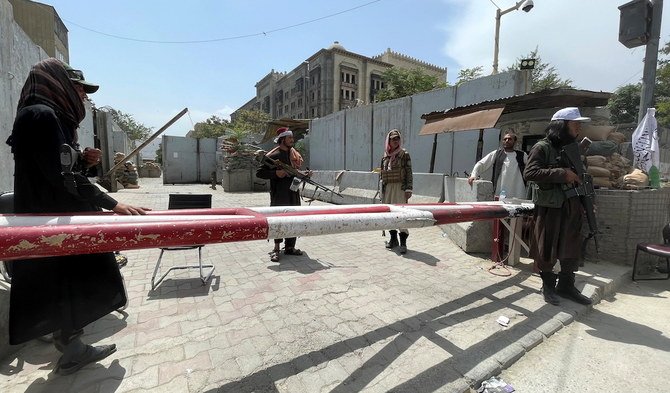
- ARAB NEWS
- 04 Jul 2025

More than a month after sweeping across Afghanistan, the Taliban now have the problem of governing, which they are quickly realizing is different from leading an insurgency. Food is in short supply and money is drying up. Members of the Daesh branch in Afghanistan have already conducted attacks against the Taliban.
In addition to these problems, the Taliban have another thorn in their side: A new resistance movement called the National Resistance Front of Afghanistan, located in the Panjshir Valley. While the odds are stacked against it, its situation is still interesting enough for global policymakers to watch.
The Panjshir Valley is a predominantly ethnic Tajik region located 100 km northeast of Kabul and is famous for its ability to resist outside aggression. It is strategically located in Afghanistan and is easily defended thanks to its unforgiving mountain terrain and valleys. During the 1980s, Soviet forces failed in numerous attempts to capture Panjshir. Although they would often capture much of the main valley and its villages, they always failed to capture the side valleys, which sheltered the resistance.
In the 1990s, after the Taliban first swept into Kandahar and Kabul, the main resistance movement also began in the Panjshir Valley. The leader of this resistance, Ahmad Shah Massoud, famously stated: “I will resist even if the last region left is the size of my hat.” Massoud was assassinated by Al-Qaeda two days before the Sept. 11, 2001, attacks on America. Today, the late Massoud’s 32-year-old son, Ahmad Massoud, is leading the new anti-Taliban resistance from Panjshir. He has a broad following because of his father’s legacy.
Exact information about the number of former Afghan soldiers, commandos and police that have made it to Panjshir to join the NRF is unknown, but estimates claim the number is in the thousands. The status of the group’s ammunition stockpiles is unknown. While the Panjshir has plenty of water, food and other commodities may be in short supply. The Taliban has encircled the region and captured large sections of the main valley. Just like in Soviet times, the NRF controls all the side valleys, which are equal to about 60 percent of the province. The Taliban has blocked internet connectivity and mobile phone service, meaning that any information that makes its way out of Panjshir is limited and often skewed in favor of the Taliban.
Right now, the only resistance force is the NRF. The next few months will determine how viable a movement it will be.
Luke Coffey
While there has been no statement by the NRF outlining its short-term goals, by analyzing the current situation alongside the historical parallels to the 1990s, one can draw some conclusions. The first thing the NRF will want to do is survive until winter. Panjshiris are accustomed to winter and mountain warfare. Over the past two decades, the winter months in Afghanistan also coincided with an ebb in the fighting with the Taliban.
The NRF probably suspects that, if it can make it through winter, it will have time to consolidate and grow and be better prepared to resist the Taliban in the spring.
If the opportunity presents itself, the NRF will likely try expanding its territorial control to the north in the Afghan provinces of Badakhshan, Takhar and possibly Baghlan. While the NRF’s military capabilities are limited, these three provinces are mainly populated by ethnic Tajik Afghans and are most likely to be sympathetic to the NRF. Critically, control of these provinces could create an important land bridge with Tajikistan. Of all the Central Asian countries, Tajikistan has been the most critical of the Taliban and the most supportive of the ethnic Tajik community in Afghanistan.
In the longer term, the NRF might try recapturing strategic locations such as the Salang Tunnel and Bagram Airfield. It is unlikely that it currently has the manpower or military capability to do this, but there is no doubt that this is an aspiration. The Panjshir Valley is close to the Salang Tunnel, which provides the main route through the Hindu Kush mountains that connect northern Afghanistan with the south. The capture of Bagram would serve both a symbolic and practical purpose — symbolic because Bagram was the center of gravity for US military operations in Afghanistan for two decades and practically because Bagram would give the NRF an airlink to the outside world.
The NRF faces a desperate situation against a determined and emboldened enemy. The NRF also feels abandoned by the international community, especially the US. The actions of the Biden administration have left few good policy options to pursue in Afghanistan. However, the most immediate thing the international community can do to help the NRF is refuse to recognize the Taliban as the legitimate government of Afghanistan. Considering the current makeup of the caretaker government, under these circumstances alone, it is inconceivable that the international community should recognize the Taliban.
It is not in the interest of the international community that the Taliban is in power. With the emergence of a resistance movement in Panjshir, and the Taliban in control of Kabul, Afghans and the international community have returned to a similar situation faced in the mid-1990s.
It is almost inevitable that other resistance movements will spring up across the parts of Afghanistan that the Taliban will have difficulty controlling and governing. Right now, the only resistance force is the NRF. The next few months will determine how viable a movement it will be.